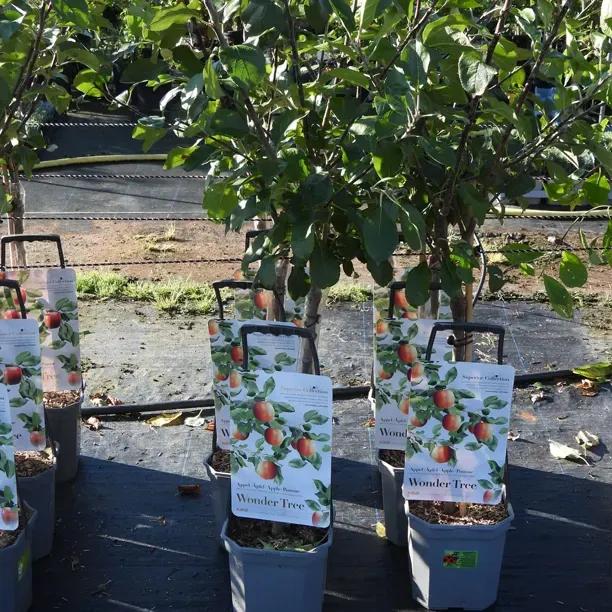Santana Mini Patio Apple Trees
The details
- Only sold as a mini patio tree
- Eating: Firm & crunchy, good flavour with a hint of roses.
- Spur bearer
- Self sterile. Pollinator
- Pollination Group C
- Harvesting: Late September.
- Stores until the end of the year
- Hypoallergenic
- Pot grown. Year round delivery
- RHS Award of Garden Merit
Recommended extras
Description
Santana Mini Patio Apple Trees: Eating
Firm and crunchy, with a good balance of acidity and sweetness, a hint of roses. Recommended for people who are allergic to other apples.
Browse our range of apple trees or all our fruit trees.
Features:
- Only sold as a mini patio tree
- Eating: Firm & crunchy, good flavour with a hint of roses.
- Spur bearer
- Self sterile.
- Pollinator
- Pollination Group C
- Harvesting: Late September.
- Stores until the end of the year
- Hypoallergenic
- RHS Award of Garden Merit
Rootstocks:
Wonder Trees are an innovative type of miniature patio fruit tree. Santana uses a M9 rootstock with a high graft to control their vigor.
Pollination Partners for Santana
Your trees are self sterile and their flowers must be pollinated to make fruit.
Santana is in pollination Group D.
This means that they will cross-pollinate with other apple trees in pollination Groups C, D and E.
Use our Fruit Pollination Checker to quickly find pollination partners, or read our Guide to Apple Tree Pollination to learn more.
Disease notes:
Disease susceptibility: Scab, Mildew. Somewhat susceptible to fire blight.
Did You Know?
Bred in 1978 by the Dutch University of Wagniningen's Centre for Plant Breeding and Reproduction Research from Elstar and Priscilla. In a 2007 study of 15 people with allergies to apples, half reported no reaction to Santana, and another quarter reported such a small reaction that they would eat it again in the future.
Apple Tree Delivery Shapes:
Santana is only sold as a dwarf, mini patio tree.
Planting Instructions
Notes on planting Santana:
All fruit trees like a rich soil with decent drainage, protection from the wind and plenty of sun. Apple trees like clay soil, as long as it is not prone to bad waterlogging.
Prepare your site before planting:
Improving the soil in advance of planting your apple trees will help them establish quickly and be productive for years to come. After you have destroyed all the weeds and grass, you can dig the soil over. Remove any stones and rubbish and mix in well rotted compost or manure down to the depth of about 2 spades.
You can do this on planting day, but when you do it weeks or months in advance, you will give the soil time to settle again.
Remember to water establishing apple trees during dry weather for at least a year after planting.
Apple Tree Planting Accessories:
We recommend using mycorrhizal "friendly fungi" on the roots of all new trees, especially if your soil is poorly fertile.
After you plant an apple tree, the most important thing to do is water it in dry weather and weed around it. Both of these will be necessary for at least a year after planting. We recommend using a mulch mat as well.
The best tip for helping your tree to establish and quickly become mature and productive is to remove all the fruit that it produces in the first year after planting, as soon as the flowers fade. This will give the tree a chance to develop its roots, which are the foundation of the tree's strength, and sturdy branches that can bear the weight of a heavy crop without snapping.
Hygiene & Diseases:
Dead, damaged or diseased wood can be pruned off as soon as it appears.
Disinfect your pruning tools between every cut if there is any sign of disease.
Burn or dispose of any diseased material, do not compost it.


